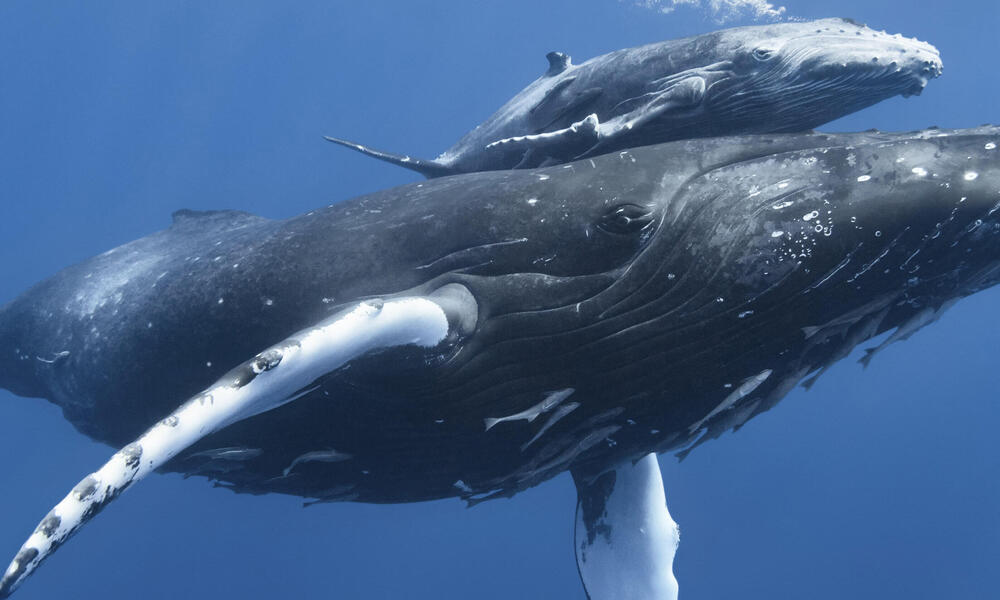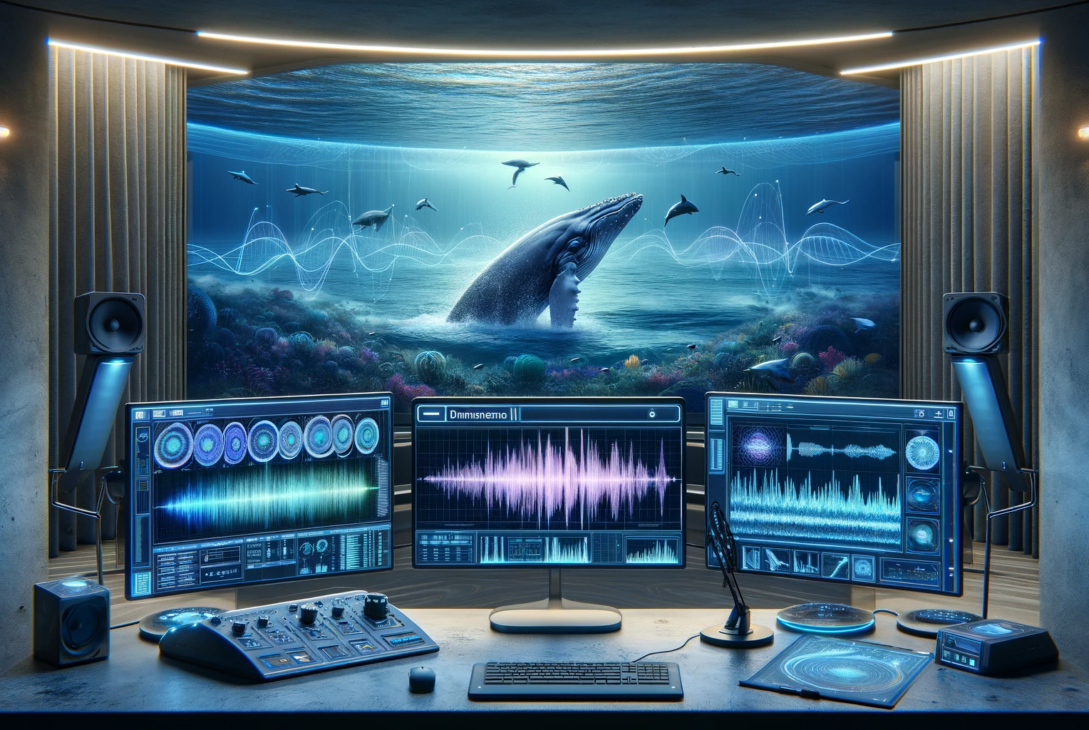In the vast, mysterious depths of our world’s oceans, a symphony of sounds reverberates through the water. These sounds are the calls, clicks, and songs of the magnificent creatures that inhabit the underwater realms. Among these creatures, whales hold a special place, renowned for their haunting songs and complex communication systems. Yet, despite our fascination with these giants of the sea, much of their language remains an enigma. This is where the incredible potential of AI technology comes into play.
The Enigmatic World of Whales
Whales, the largest animals on Earth, have been the subjects of fascination for centuries. Their songs, which can be heard across vast distances in the ocean, have intrigued scientists and nature enthusiasts alike. Whales communicate using a sophisticated system of clicks, whistles, and songs, and it is believed that these vocalizations play a crucial role in their social interactions, navigation, and even hunting strategies.
For years, researchers have grappled with the challenge of comprehending the meaning and nuances of these complex sounds. Traditional methods involved underwater microphones or hydrophones, which could capture whale vocalizations, but interpreting these sounds was a laborious and often imprecise task, heavily reliant on human expertise.
The Advent of AI Technology
The dawn of artificial intelligence has brought with it the promise of revolutionizing our understanding of the natural world. In recent years, AI algorithms, particularly those related to machine learning and deep learning, have made significant strides in various fields, from healthcare to finance. One of the most promising applications of AI technology lies in its potential to decode the intricate language of whales.
AI-based algorithms, when trained on massive datasets of recorded whale sounds, can identify patterns, nuances, and associations that elude the human ear. By processing and analyzing these vast datasets, AI can provide invaluable insights into the behavior, communication, and even emotions of whales.
The Role of Machine Learning
Machine learning, a subset of artificial intelligence, plays a pivotal role in this endeavor. Researchers feed vast amounts of recorded whale vocalizations into machine learning models, which then use statistical techniques to identify and categorize different types of sounds. Over time, these models learn to recognize patterns and associations within the data, allowing them to decipher the meanings and intentions behind the sounds.
One of the remarkable advantages of machine learning in this context is its ability to process large volumes of data quickly and efficiently.
While it would take years for a human to manually analyze such vast datasets, machine learning algorithms can accomplish this task in a matter of hours, if not minutes. This acceleration in data analysis has been a game-changer for researchers studying whales, enabling them to unlock new insights at an unprecedented pace.
Aiding Conservation Efforts
The implications of AI-powered whale sound deciphering extend far beyond scientific curiosity. They have the potential to drive significant advancements in the conservation of these magnificent creatures. Let’s explore how AI technology is contributing to various aspects of whale conservation.
Species Identification and Tracking
One of the fundamental challenges in whale conservation is accurately identifying and tracking different species. With many whale species facing the threat of extinction, it is vital to monitor their populations and understand their migratory patterns. AI technology, equipped with the ability to identify whale species based on their vocalizations, is instrumental in these efforts.
By deploying underwater listening devices connected to AI algorithms, researchers can detect and identify specific whale species in real-time. This information is invaluable for assessing population health, understanding habitat usage, and implementing targeted conservation strategies.
Monitoring Behavioral Changes
Whales are highly sensitive to environmental changes, and alterations in their behavior can signal underlying issues such as pollution, climate change, or disturbances caused by human activities like shipping and oil drilling. AI technology, in conjunction with acoustic monitoring, enables researchers to detect shifts in whale behavior patterns.
Machine learning models can recognize deviations in the timing and frequency of whale calls, indicating potential stress or disruptions in their environment. This early warning system allows conservationists to take timely actions to mitigate threats and protect these vulnerable species.
Reducing Collisions with Ships
Collisions between whales and large vessels pose a significant threat to whale populations, especially in busy maritime routes. By incorporating AI technology into maritime navigation systems, ships can receive real-time alerts about the presence of whales in their vicinity.
These AI-driven warning systems use acoustic data to identify whale locations, providing ships with crucial information to adjust their routes and avoid potential collisions. This technology not only safeguards whales but also minimizes the risk to human lives and property damage.
Studying Social Interactions
Understanding the social structures and interactions within whale populations is essential for effective conservation efforts. AI technology can analyze the intricate vocalizations exchanged between whales during different social contexts, shedding light on their communication patterns.
For instance, researchers have used AI to decipher the songs of humpback whales, revealing that these songs can vary across different regions and change over time. Such insights can inform conservation strategies tailored to specific populations and their unique communication behaviors.
Evaluating Stress Levels
Environmental stressors, such as noise pollution from shipping and industrial activities, can have adverse effects on whales. Prolonged exposure to noise pollution can lead to stress and disrupt crucial behaviors like feeding and breeding.
AI technology can help quantify the impact of noise pollution by monitoring changes in whale vocalizations and assessing the stress levels of individuals and populations. This data is instrumental in advocating for stricter regulations to mitigate the harmful effects of human activities on marine ecosystems.

Photo taken from World Wildlife Fund.
The AI Behind Deciphering Whale Sounds
The AI algorithms and techniques employed in deciphering whale sounds represent a marriage of cutting-edge technology and a deep appreciation for the natural world. In this section, we will delve into the inner workings of AI systems, explore recent breakthroughs, discuss ongoing challenges, and examine the ethical considerations surrounding this transformative field.
AI Algorithms at the Heart of Whale Sound Deciphering
The success of AI in deciphering whale sounds hinges on its ability to process vast amounts of acoustic data, recognize patterns, and draw meaningful conclusions. Here are some key AI algorithms and techniques central to this endeavor:
Deep Learning Neural Networks: Deep learning models, particularly convolutional neural networks (CNNs) and recurrent neural networks (RNNs), are the backbone of AI systems for whale sound analysis. CNNs excel at extracting features from spectrograms of whale calls, while RNNs are used to model temporal dependencies in the data, capturing the sequence of sounds.
Spectrogram Analysis: Spectrograms are visual representations of sound, depicting how its frequency and amplitude change over time. AI algorithms analyze these spectrograms to identify distinct features within whale vocalizations, such as the frequency of clicks or the patterns in song sequences.
Pattern Recognition: AI models use pattern recognition to categorize different types of whale sounds, such as songs, clicks, or social calls. This categorization is vital for understanding the context in which these sounds are produced and their significance in whale communication.
Recent Breakthroughs in Whale Sound Deciphering
The field of AI-assisted whale sound deciphering has witnessed remarkable breakthroughs in recent years, ushering in a new era of understanding and conservation. Some notable developments include:
Species-Specific Identification: AI algorithms have become increasingly proficient at identifying not only general whale categories but also distinct species. This capability is essential for tailored conservation efforts focused on protecting endangered species like the North Atlantic right whale or the vaquita.
Real-Time Monitoring: Advances in AI and sensor technology have enabled real-time monitoring of underwater environments. Autonomous underwater vehicles (AUVs) equipped with AI algorithms can listen for whale vocalizations and relay this information to researchers on land, allowing for immediate response to threats.
Big Data Analysis: The collection of extensive acoustic datasets from various parts of the world’s oceans has expanded our understanding of whale populations and migration patterns. AI-driven data analysis has revealed unexpected insights, such as variations in humpback whale songs across different ocean basins.
Behavioral Modeling: Machine learning models are now capable of constructing detailed behavioral profiles of individual whales or entire populations. These profiles can include information about feeding habits, mating rituals, and even the emotional states of these magnificent creatures.
Challenges in Deciphering Whale Sounds
While AI technology has made significant strides in the realm of whale sound deciphering, several challenges persist:
Data Collection: Obtaining high-quality acoustic data from remote oceanic locations remains a logistical and financial challenge. These data are essential for training AI models and validating their accuracy.
Computational Power: Processing large datasets and running complex AI algorithms require substantial computational power. Researchers must grapple with the cost and energy consumption associated with these computations.
Ethical Concerns: The deployment of AI-equipped monitoring systems in sensitive marine environments raises ethical questions. Balancing scientific research with concerns about the disturbance of natural habitats is an ongoing debate in the field.
Data Privacy: AI-driven monitoring systems capture vast amounts of acoustic data, some of which may include incidental recordings of other marine species. Protecting the privacy of non-targeted species is an ethical consideration that researchers must address.
Ethical Considerations in AI-Assisted Whale Conservation
The use of AI technology in whale conservation has led to critical ethical considerations, particularly in the context of maintaining a harmonious relationship between humans and the marine environment:
Environmental Impact: The deployment of underwater monitoring systems, powered by AI, can potentially disrupt marine ecosystems. Researchers must strive to minimize the ecological footprint of their technology while maximizing its benefits.
Privacy and Informed Consent: The recording and analysis of marine sounds may inadvertently capture sounds from other marine life forms. Respecting the privacy and rights of these non-targeted species is essential.
Responsible Research: Researchers using AI to decipher whale sounds must conduct their work responsibly, adhering to ethical guidelines and prioritizing the welfare of the whales and the marine environment.
Conservation Priorities: While AI technology can provide valuable data, it is essential to prioritize conservation actions based on these insights. Ethical decision-making should guide the allocation of resources and efforts to protect whale populations.
Conclusion
The use of AI technology to decipher whale sounds represents a remarkable fusion of technological innovation and environmental conservation. It has revolutionized our understanding of these magnificent marine creatures, providing insights into their behavior, communication, and vulnerabilities that were previously unimaginable.
As AI algorithms continue to evolve and improve, researchers are poised to uncover even more secrets hidden in the depths of our oceans. With responsible and ethical research practices, AI-assisted whale sound deciphering holds the potential to play a pivotal role in the preservation of these awe-inspiring giants of the sea. As we continue to explore the intricate language of whales through the lens of AI, we move one step closer to safeguarding their future for generations to come.




